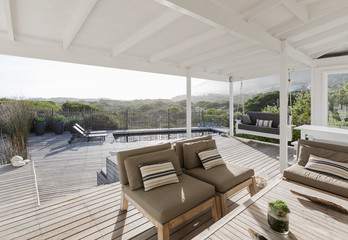
A home patio is more than just an outdoor extension of your living area. It’s a versatile space that can transform your backyard into a relaxing retreat, an entertainment hub, or a gathering spot for family. Whether you’re planning a cozy patio for morning coffee or a stylish setting for weekend barbecues, creating the perfect patio can significantly enhance your home’s value and curb appeal.
Benefits of Having a Home Patio
Patios provide numerous advantages for homeowners. First, they extend your living space without requiring major construction. Unlike indoor rooms, a patio blends the comfort of home with the beauty of the outdoors. This makes it an ideal spot for relaxation, reading, or enjoying nature.
Another major benefit is entertaining guests. Patios offer a natural gathering place for social activities, from casual dinners to lively summer parties. With the right furniture and lighting, your patio can become the heart of outdoor entertainment.
A well-designed patio can also increase your property’s value. Prospective buyers often appreciate functional outdoor spaces that require minimal upkeep. Adding features like a pergola, built-in seating, or decorative stonework can make your patio a focal point that boosts both aesthetic appeal and resale potential.
Choosing the Right Patio Style
When designing a patio, consider the overall style of your home. A modern home may benefit from sleek, minimalist designs with clean lines and neutral tones. For a more traditional or rustic home, stone or brick patios with warm colors can complement the architecture beautifully.
Materials play a crucial role in defining your patio’s look and durability. Common options include concrete, natural stone, brick, and pavers. Concrete is versatile and cost-effective, while natural stone offers a timeless appeal with its unique textures and colors. Brick provides a classic, charming look, and pavers allow for creative patterns and designs.
Planning Your Patio Layout
Proper planning ensures that your patio functions well and maximizes available space. Start by determining the main purpose of your patio. Is it meant for dining, lounging, or both? Once you know its function, you can plan the layout accordingly.
Consider traffic flow and accessibility. Ensure there is enough space for chairs, tables, and pathways without overcrowding the area. Incorporating multiple zones, such as a dining area and a lounging corner, can make the patio feel more dynamic and inviting.
Lighting is another essential aspect. Outdoor lighting not only enhances safety but also sets the mood for evening gatherings. String lights, lanterns, and recessed floor lights are popular choices that create a warm and welcoming ambiance.
Adding Comfort and Style
Furniture selection is key to creating a comfortable and stylish patio. Opt for durable, weather-resistant materials such as aluminum, teak, or synthetic wicker. Cushions and pillows can add a pop of color and make the space more inviting.
Shade options are also important. Depending on your climate, consider installing a pergola, canopy, or retractable awning to protect against sun and rain. These features add both comfort and architectural interest, making your patio usable in a variety of weather conditions.
Incorporating greenery can further enhance the atmosphere. Planters with flowers, shrubs, or even small trees can create a sense of privacy and blend the patio seamlessly with your garden. Vertical gardens or trellises are also excellent options for smaller spaces.
Patio Features That Add Value
To elevate your patio, consider adding functional and decorative features. Fire pits or outdoor fireplaces provide warmth and create a cozy gathering spot. Water features, such as fountains or small ponds, add tranquility and a touch of luxury.
Outdoor kitchens are increasingly popular, offering a convenient space for cooking and entertaining. Even a simple barbecue station or countertop area can transform your patio into a functional dining destination.
Decorative elements like rugs, artwork, and outdoor curtains help define the space and reflect your personal style. Choosing elements that complement your home’s exterior creates a cohesive and harmonious look.
Maintenance Tips for a Long-Lasting Patio
Proper maintenance ensures your patio remains attractive and functional for years to come. Clean surfaces regularly to prevent dirt and debris buildup. For stone or brick patios, consider sealing the surface to protect against stains and weather damage.
Furniture should be stored or covered during harsh weather conditions to prolong its lifespan. Regularly inspect lighting, shade structures, and other features to address any wear and tear before it becomes a problem.
Plant care is also important. Prune shrubs, water potted plants, and manage weeds to keep the patio area looking fresh and vibrant. A well-maintained patio not only enhances enjoyment but also preserves the value of your home.
Making the Most of Your Patio Space
Maximizing your patio’s potential involves thoughtful design and personalization. Incorporate elements that reflect your lifestyle, whether it’s a cozy reading nook, a space for yoga and meditation, or a lively area for hosting friends.
Consider seasonal adaptability. Adding removable or adjustable elements like heaters, shade sails, or portable furniture allows you to enjoy the patio year-round. Multi-functional spaces ensure that your patio remains practical and appealing in different seasons.
A home patio is more than just an outdoor space—it’s an investment in comfort, style, and lifestyle. With careful planning, the right materials, and thoughtful design, you can create a patio that enhances your home’s beauty, value, and functionality. From intimate gatherings to grand celebrations, your patio can become a central hub for memorable experiences. Transforming your backyard into a stunning patio space is a decision that offers lasting rewards, making your home a true sanctuary both inside and out.